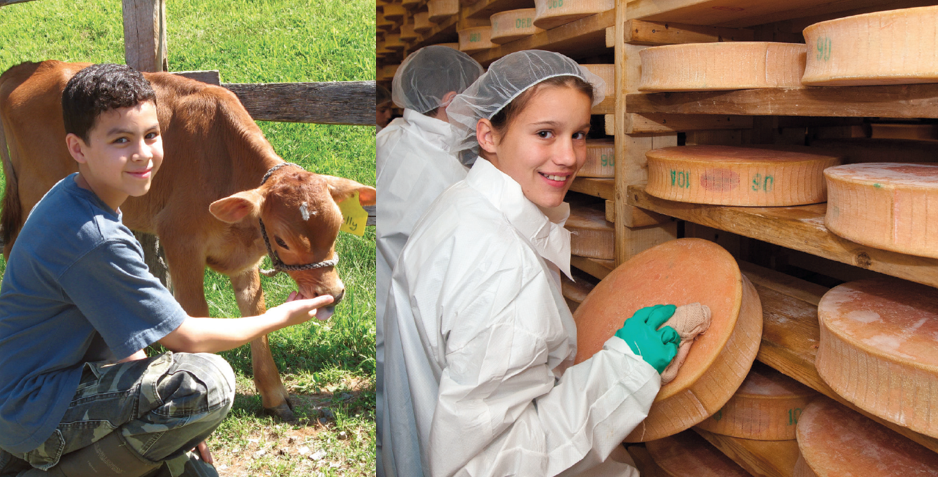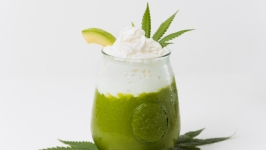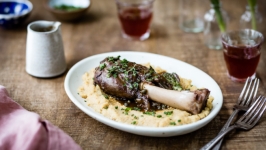Kids & Curds: Children Learn About Life On the Farm at Spring Brooks Farm
High up in the Alps, when the early winter dusk falls the prospect of a savory hot cheese dish and a glass of beer or wine in front of a roaring fire is irresistible. Sharing raclette has been a traditional way to get together for a relaxing evening with friends and family in French and Swiss Alpine communities for a very long time because it is so simple and so satisfying.
Raclette is a semi-soft cow’s milk cheese with a creamy, nutty flavor ideally suited to melting. Originally the wheel of cheese was heated in front of a fire and the gooey melted cheese scraped off periodically onto welcoming plates or thick slices of bread. (The name of the dish comes from the French racler, meaning to scrape.) According to legend, cow herders discovered this technique during the many months spent high up on the Alpine slopes with their herds.
Today eating raclette remains a common tradition in Alpine communities. It is usually served with cornichons, roasted potatoes and pickled onions, and perhaps some thinly sliced beef. Although it shares its geographic origins and involves melted cheese, raclette is not the same as fondue. It’s simpler to prepare and, though it can involve specialized equipment, it can also be made in a heavy frying pan.
The mountains of Vermont share many Alpine characteristics (as well as the presence of lots of cows) and the production of an artisan raclette-style cheese by Spring Brook Farm in Reading is a most welcome addition to the Vermont cheese scene. Located on a beautiful hillside with the vista of mountains all around, Spring Brook Farm has two interlocking avocations: the production of two award-winning cheeses and the introduction of city kids to country life on a farm.
Although the farm has welcomed groups of children since 1993, the cheesemaking operation began in 2008. With 42 spotless stalls for their Jersey cows, founders Karli and Jim Hagedorn started with a semi-hard raw milk cheese made in the tradition of the Tarentaise Valley in the Haut Savoie region of the French Alps. John Putnam—owner of Thistle Hill Farm in North Pomfret, where he’d been handmaking Tarentaise for several years—offered to help the Hagedorns get started, and the farm now produces over 60,000 pounds of cheese every year.
Two years later Spring Brook introduced Reading, the Vermont answer to the European raclette. To make sure they were on the right track, they engaged the help of a young French cheesemaker from France’s Haut-Savoie region, who continues to come every year to consult with Cheese Program Director Jeremy Stephenson and his team.
The cheesemakers follow all the traditional French steps and use French equipment. In the light and airy cheesemaking house, large copper-lined vats receive the milk from their cows, the correct French strain of bacteria and some rennet, the combination of which sparks the singular biological and chemical process that results in the perfect raclette.
It takes 100 pounds of milk to make 10 pounds of cheese. With two varieties in production they needed to increase their raw milk supply, so in addition to their own Jerseys they use milk supplied from two multi-generational neighboring farms, which provide the high-quality, carefully controlled milk they need.
“It’s very gratifying to be able to help other farms in the area be successful,” says Stephenson. The cows roam the hillsides of central Vermont eating the native grasses, just as they do in Haut-Savoie, and in winter they are fed a special organic feed.
Once formed into 20-pound wheels, both types of cheese begin the process of aging in the cool, damp atmosphere of the aging room with its controlled temperature and humidity. The process, known as affinage, is a skill that takes real dedication to perfect. It’s this process that accounts for up to half of the flavor of any cheese. The Reading Raclette is aged over three to four months and the Tarentaise for 10 months. During this time the wheels will be washed and turned at least 60 times under the careful attention of affineur Antoinette Jacobson.
“There are many decisions to be made on a daily basis in this process,” says Stephenson. “It is definitely an art that involves a lot of labor.” In 2013 Spring Brook produced 120,000 pounds of their unique and roundly flavorful Reading Raclette cheese.
All the profits from the cheesemaking go the Farms for City Kids Foundation. During the year groups of children visit for a week and take part in all the farm chores. Learning how to make cheese is a popular learning experience for them ... as is learning how to milk a cow, of course.
Spring Brook’s Reading Raclette and its Tarentaise can be found in specialty stores all over the country and both have won several awards including first place in category at the 2013 US Cheese Championships. You can find out more
about them at FarmsForCityKids.org.








